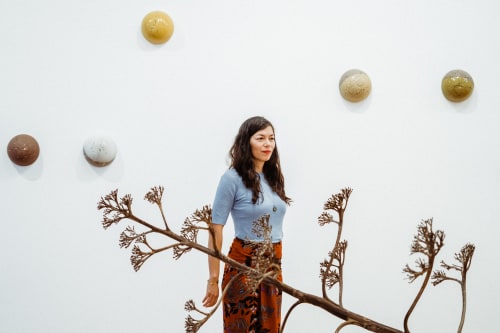Jennifer Tee eagerly anticipates the tulip harvest every spring. Born in Arnhem in the Dutch countryside, Tee’s life was always framed by the floral landscape. So in 2012, when she was commissioned to create a work at Amsterdam’s Centraal Station, it was only natural that she would pick tulips as her medium. During her initial explorations for the design, she stumbled upon palepai and tampan textiles, traditional woven cloths from the Lampung region of southern Sumatra, Indonesia. Here, she discovered an opportunity to weave together her Dutch and Chinese Indonesian heritage.
After four years of research, she created her first two tulip collages, laying the foundation for what would become a pivotal project: Tulip Palepai, navigating the river of the world (2017), a grand collage fashioned from over 100,000 dried tulip petals. Motivated by this new practice, Tee began a seasonal project, where each spring, she creates two more “Tampan Tulips” collages. “The properties of the material can be part of the meaning of the work,” Tee told Artsy, discussing these cornerstone works at her inaugural solo exhibition in New York, “Ancestral Beginnings, Sessile Beings,” on view at Tina Kim Gallery until March 16th.
The series “Tampan Tulips” draws inspiration not only from the colorful geometric aesthetics of the traditional tampan textiles but also from their thematic origins—namely, the delicate and fleeting nature of life. Turtles, birds, giant trees, and human beings are among the elements featured in Tee’s works. A major recurring motif, positioned at the bottom of each, is the ship. This, Tee explained, was “the subject I was very drawn to at first: the ship and what it symbolized—this travel from one place to another or from life to death.”
In works like Tampan World Mountain, Ancestral Beginnings (2023)—a massive square collage depicting a red-yellow bird made of petals from a variant called the “firecracker” tulip—Tee also pays homage to the multicultural society that first devised the tampans. Facilitated by Indonesia’s role as a global hub in the spice trade, these original textiles were cross-cultural artifacts that, for Tee, have become personally tied to her identity. Her tampan-inspired collages represent her father’s migration from Indonesia to the Netherlands in the 1950s and her maternal grandfather’s vocation as a tulip bulb exporter.
The meticulous process of drying and arranging the tulip petals, bound by the timing of the annual tulip harvest, limits Tee to producing only two collages each year, a constraint that exemplifies her engagement with the themes of transience and preservation.
Even so, she now replicates her original collages with piezography, an ultra-refined printmaking process. For the show, she presents several identically sized editions, including Tampan Ship of Souls #2(2020), a bright tapestry made from black, yellow, red, and green petals immortalized in a print nearby.
This series, and Tee’s work more broadly, is anchored in exploring “the soul in limbo,” an ethos that can be traced back to Surrealist artist André Breton’s novel Nadja and Tee’s admiration for the modernists, particularly Hilma af Klint and Wassily Kandinsky, for whom art and abstraction were conduits for occultism. Instead of painting abstract forms, Tee uses raw materials because of, in her words, their “resonance.”
In the back gallery room, Tee presents three hanging textile works, made of pineapple cloth. She calls these “sessile beings”—organisms like trees rooted in one place. Here, she suggests a broader interpretation of ancestry that encompasses not just human life but the entirety of ecological history, challenging manmade distinctions: “How would that change us if we would try to weave ourselves back into being less human and being more like those plants, trees, or mycelium networks—non-hierarchical,” she said. The famous Dutch tulips, in this reading, represent something more substantial: not just ephemera but vital, necessary members of her family history.
—Maxwell Rabb


